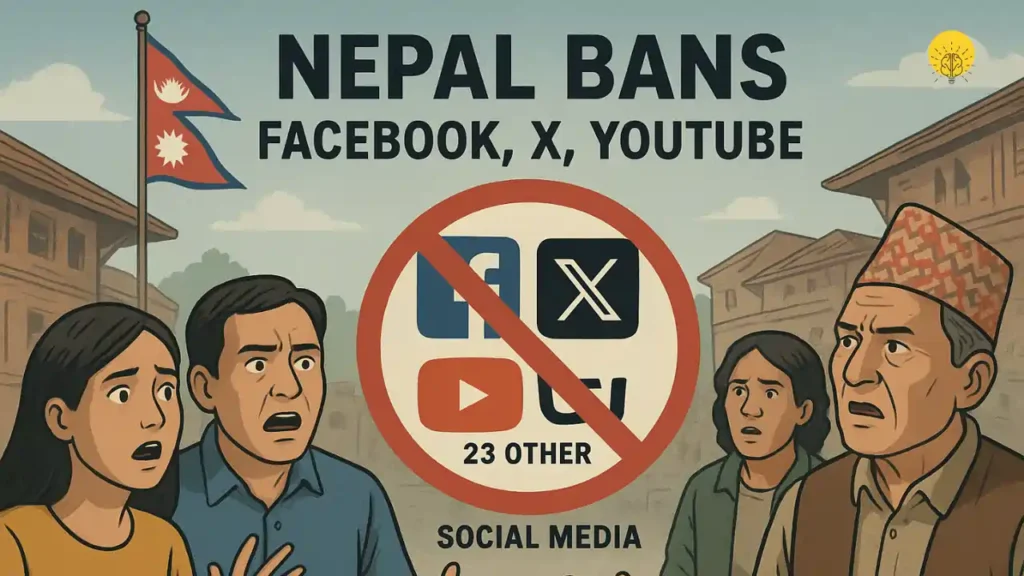New Delhi: In a shocking move that has sparked global outrage and concerns over freedom of expression, the Nepal government has imposed a ban on 26 major social media platforms, including giants like Facebook, X (formerly Twitter), YouTube, Instagram, and others. This decision, announced on September 4, 2025, stems from the platforms’ failure to comply with mandatory registration rules set by Nepali authorities. As Nepal social media ban 2025 trends worldwide, critics argue it’s a veiled attempt to curb dissent and control online narratives.

Background of the Nepal Social Media Ban: Registration Requirements and Supreme Court Ruling
The roots of the Nepal bans Facebook X YouTube controversy trace back to a recent Supreme Court directive. Just two weeks prior to the ban, on August 22, 2025, Nepal’s top court ruled that all online and social media platforms, whether domestic or foreign, must register with a competent authority in the country. This ruling came while hearing a contempt of court case, emphasizing that no platform should operate without formal registration.
Following the court’s order, the Nepali Cabinet decided on August 25, 2025, to issue a notice compelling compliance. The Ministry of Communications and Information Technology (MoCIT) then set a seven-day ultimatum on August 28, 2025, requiring platforms to register, establish an office in Nepal, appoint a local contact person, and ensure adherence to the Directives Relating to the Regulation for Usage of Social Media, 2080. The deadline expired on Wednesday night, September 3, 2025, with no registrations from the targeted companies.
On Thursday, September 4, 2025, under the leadership of Prime Minister K.P. Sharma Oli, the government acted swiftly. A meeting at the Ministry, attended by Minister Prithvi Subba Gurung, ministry officials, representatives from the Nepal Telecommunications Authority (NTA), telecom operators, and internet service providers (ISPs), resulted in the decision to enforce the ban. The MoCIT issued a public notice ordering the NTA to deactivate all non-registered social media sites until they comply.
This isn’t the first instance of such restrictions in Nepal. In November 2023, the Pushpa Kamal Dahal-led government blocked TikTok, drawing widespread criticism. The ban was lifted in August 2024 after TikTok registered and met regulatory requirements. Similarly, Telegram faced a ban in July 2025 over allegations of facilitating online fraud and money laundering. TikTok was again briefly restricted in August 2024 but resumed operations post-registration in November 2024.
List of Banned Platforms and Reasons Cited by the Government
The Nepal social media ban 2025 affects a total of 26 platforms, as outlined by the government. The full list includes Facebook, X, YouTube, Instagram, WhatsApp, Messenger, Discord, Reddit, WeChat, Snapchat, Botim, Viber, and 14 others not explicitly named in initial announcements but implied to be major global apps. However, there’s some confusion around Viber—while early reports included it in the ban list, later clarifications noted that Viber and TikTok remain operational as they have completed registration. Only five platforms, including TikTok and Viber, have formally registered, with two more in the process.
The government’s primary justification is non-compliance with registration rules aimed at addressing misinformation, online hate, rumors, and cybercrime. Minister Gurung stated that platforms were given ample time and repeated reminders but ignored the requests. Spokesperson Gajendra Thakur (also referred to as Gajendra Kumar Thakur in some reports) expressed hope on Wednesday afternoon that companies would approach before midnight, but none did. He confirmed that unregistered platforms would be deactivated starting Thursday.
The registration process requires appointing a local contact, a grievance handler, and a person for self-regulation. Authorities argue this ensures accountability and alignment with local laws. The move follows a 2023 directive mandating local presence for social media operations. Despite the ban announcement, AFP reported that platforms like Facebook and X remained accessible on Thursday, September 4, 2025, suggesting a phased implementation or technical delays.
Criticisms and Concerns: Impact on Free Speech, Press Freedom, and Daily Life
The Nepal bans 23 other social media platforms decision has ignited fierce backlash from free speech advocates, civil society groups, and media organizations. Critics contend that the ban is less about regulation and more about silencing dissenting voices and tightening control over online speech. Ujjwal Acharya, director of the Center for Media Research, labeled the move as misguided and harmful to Nepal’s democratic reputation. He argued that the government failed to evaluate the impact on common citizens, stating, “This decision is going to harm Nepal’s democratic reputation for a long time and will create a lasting negative perception globally.”
Acharya further pointed out that platforms likely refused registration due to the government’s unrealistic and intrusive conditions, including stringent oversight and control measures. He emphasized that social media is integral to daily life beyond political expression—serving as an easy, affordable tool for communication and business. “In trying to silence dissent, the government has miscalculated,” he added.
The Committee to Protect Journalists highlighted how the ban hinders journalists’ reporting abilities and limits public access to information. The Federation of Nepali Journalists described it as undermining citizens’ right to information. Global digital rights group Access Now called the block troubling, comparing it to censorship in China. Raman Jit Singh Chima, Access Now’s Asia Pacific policy director, urged Nepal to publish blocking orders, restore access, and pursue transparent, consultative legislation. He warned of sweeping powers enabling authorities to suspend services and pressure companies into removing lawful content, potentially leading to over-blocking.
Bhola Nath Dhungana, president of Digital Rights Nepal, criticized the “controlling” approach, noting it directly impacts fundamental rights. He stressed the need for proper legal infrastructure before enforcement, saying sudden closures reflect poor governance.
Social media users in Nepal reacted immediately, posting messages they feared might be their last, calling the decision injudicious, unwise, and self-defeating. With internet penetration above 90% in Nepal, platforms like Facebook dominate with an 87% market share, followed by X at 6% and YouTube at 5%, according to Statcounter data.
Broader Implications: Economic, Social, and Global Context
The ban’s ripple effects extend to Nepal’s economy and social fabric. Nepalis heavily rely on apps like WhatsApp, Botim, Meta Messenger, Viber, and others for connecting with family members abroad. World Bank data from 2024 estimates Nepal’s personal remittances at 33.06% of GDP, underscoring the cross-border importance of these platforms for migrant workers and their families.
The Oli government, in power for about 14 months, has faced accusations of being vindictive toward online critics. Earlier this year, a proposed bill to regulate social media drew opposition, with experts warning it could control all online activity under the guise of regulation. The bill includes fines and imprisonment for content deemed against national interest, raising fears of threats to press freedom and digital expression. Despite this, the government maintains it has no intention to restrict free speech.
Globally, the Nepal social media ban 2025 aligns with a trend of tightening oversight on big tech. Countries like the United States, European Union, Brazil, Australia, India, and China have implemented measures for misinformation, data privacy, online harm, and national security. India requires local compliance officers and takedown mechanisms, while China enforces strict censorship and licensing.
The Supreme Court ruling upheld registration to combat misinformation but did not explicitly mandate a ban; it only directed the government to create legal arrangements within the law. This has fueled arguments that the ban oversteps judicial intent.
Company Responses and Path to Restoration
Major companies like Meta (owner of Facebook, Instagram, WhatsApp), Google (YouTube’s parent Alphabet), Snap (Snapchat), and others did not respond to requests for comment. The Ministry stated that access would be restored once platforms register in Nepal.
Previously, the government had issued four similar requests via the Ministry, but this was the first backed by a Cabinet decision, adding weight to the enforcement.
Public and Expert Reactions: A Nation on the Edge
As news of the ban spread, social media buzzed with criticism. Users lamented the loss of vital tools for entertainment, news, and business. Sanjeev Satgainya’s report from Kathmandu, updated on September 5, 2025, at 08:36 am IST, captured the immediate fallout. Aishwarya Panda’s piece, updated at 08:25 am IST on the same day, questioned why Nepal seemed “angry” and suddenly targeted these platforms.
Images circulating online (such as those depicting protests or platform icons with ban symbols) illustrate the public discontent, though specifics remain unverified in reports.
In summary, Nepal bans Facebook X YouTube and 23 other platforms marks a pivotal moment in the country’s digital landscape. While aimed at regulation, it risks damaging Nepal’s global image, economy, and democratic values. As debates rage over the proposed social media bill, the world watches to see if platforms comply or if international pressure forces a reversal. For now, millions in Nepal face disrupted connections, highlighting the delicate balance between governance and freedom in the digital age.
FAQs
1. Why did Nepal ban 26 social media platforms, including Facebook, X, and YouTube?
The Nepal government banned these platforms on September 4, 2025, due to their failure to comply with mandatory registration requirements. Following a Supreme Court ruling on August 22, 2025, all online platforms were required to register with a competent authority, establish a local office, and appoint a contact person to ensure compliance with local laws. The government cited the need to curb misinformation, online hate, rumors, and cybercrime as reasons for the regulation.
2. Which social media platforms are affected by the ban in Nepal?
The ban targets 26 platforms, including major ones like Facebook, X (formerly Twitter), YouTube, Instagram, WhatsApp, Messenger, Discord, Reddit, WeChat, Snapchat, and Botim. However, TikTok and Viber remain unaffected as they have completed the registration process. Two other platforms are reportedly in the process of registering.
3. What are the criticisms surrounding Nepal’s social media ban?
Critics, including free speech advocates and civil society groups, argue that the ban is a pretext to silence dissent and control online speech. Experts like Ujjwal Acharya from the Center for Media Research called it misguided, warning it harms Nepal’s democratic reputation. The Committee to Protect Journalists and the Federation of Nepali Journalists highlighted threats to press freedom and citizens’ right to information. Digital Rights Nepal and Access Now compared the move to censorship practices in China, citing intrusive oversight measures as a reason for non-compliance by platforms.
4. How does the ban impact Nepali citizens and the economy?
With over 90% internet penetration, platforms like Facebook (87% market share), X (6%), and YouTube (5%) are integral to daily life in Nepal. The ban disrupts communication, especially for families connecting with migrant workers abroad, who contribute 33.06% of Nepal’s GDP through remittances (World Bank, 2024). It also affects businesses, journalists, and citizens reliant on these platforms for news, entertainment, and commerce, potentially damaging Nepal’s global image.
5. Can the banned platforms regain access in Nepal, and what is the global context?
The Nepal government has stated that access will be restored once platforms register and comply with local regulations. This move aligns with global trends, as countries like the US, EU, Brazil, Australia, India, and China tighten oversight of social media for misinformation, data privacy, and national security. Nepal’s history of banning platforms, such as TikTok in 2023 and Telegram in 2025, suggests a pattern, with previous bans lifted after compliance.

